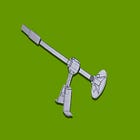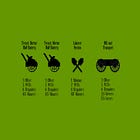On 16 February 1915, Joseph Joffre, then in command of all of the French forces fighting in France and Belgium, ordered the creation of units that would be exclusively concerned with employment of trench mortars. Composed of eighteen gunners and two pieces of trench artillery, these sections d’artillerie de tranchée were to be autonomous units.1
For administrative purposes, each of the trench mortar sections belonged to one of the field gun batteries of the army corps in which it served. Where matters peculiar to trench mortars were concerned, the non-commissioned officer in charge of each section reported to the lieutenant who served as a trench mortar officer of its army corps. When it came to food, however, each trench mortar section drew its rations from infantry unit occupying the sector in which it was located.
The internal organization of each trench mortar section provided two four-man crews for each mortar and an assistant for the section leader. Thus, while a leader and two crews stood watch in the trenches, the other half of the section would be able to rest or, what was more likely, perform such chores as the transport of shells and the improvement of firing positions.
The men of the trench mortar sections were, like the trench mortar officers of army corps, seconded from field gun batteries. Some of these, no doubt, were veterans of the crews that had been put together to serve the Louis-Phillipe mortars when the latter arrived at the front. Others were free spirits who, having found life in regularly constituted batteries somewhat less than congenial, preferred to serve in a unit with no drill books, few established routines, one non-commissioned officer, and no officers at all. Some were volunteers. Others, it seems, were not. (Comment dit-on en français … “will you take my punishment or go to trench mortars?”)
The way in which trench mortar sections filled their ranks, and their peculiar connection to various military hierarchies, led to a situation in which each trench mortar position … “became a little fiefdom, created by hard work, inventiveness, resourcefulness, and, if necessary, theft; the common achievement of a little squad that lived there as if they were property owners; obtaining a ration from here, a pair of trousers from there; free from roll call, guard duty, inspections, but also free from being relieved. Disdained by the artillery that forgot to give orders, disdained by the infantry for refusing to obey their orders, visited occasionally by the trench mortar officer who was responsible for an immense sector, the sergeant or the corporal as all-powerful, often opening and adjusting fire on his own authority.”2
It did not take long for both the trench mortars and the men who operated them to acquire suitably Bohemian nicknames. The trench mortars themselves, whether vintage, improvised, or factory fresh, became known as crapouillots.3 This led easily to the custom of referring to the men of trench mortar sections as crapouilloteurs.
For Further Reading:
To Share, Subscribe, or Support:
Ministère de la Guerre, État-Major de l’Armée, Service Historique, Les Armées Françaises dans la Grande Guerre (Paris: Imprimerie Nationale, 1931) Tome II, page 42
Bulletin des Crapouillots, March 1922, as quoted by Pierre Walline, Les Crapouillots (Paris: Charles-Lavauzelle, 1965) page 58
Before the war, crapouillot had long been used as both a mild interjection and a surname for ludicrous characters in light-hearted fiction of various kinds. Thus, for example, in a farce about a stock swindle published in the Little Magazine for Laughs in 1869, the anti-hero of the tale bore the name of “Monsieur César Crapouillot.”










